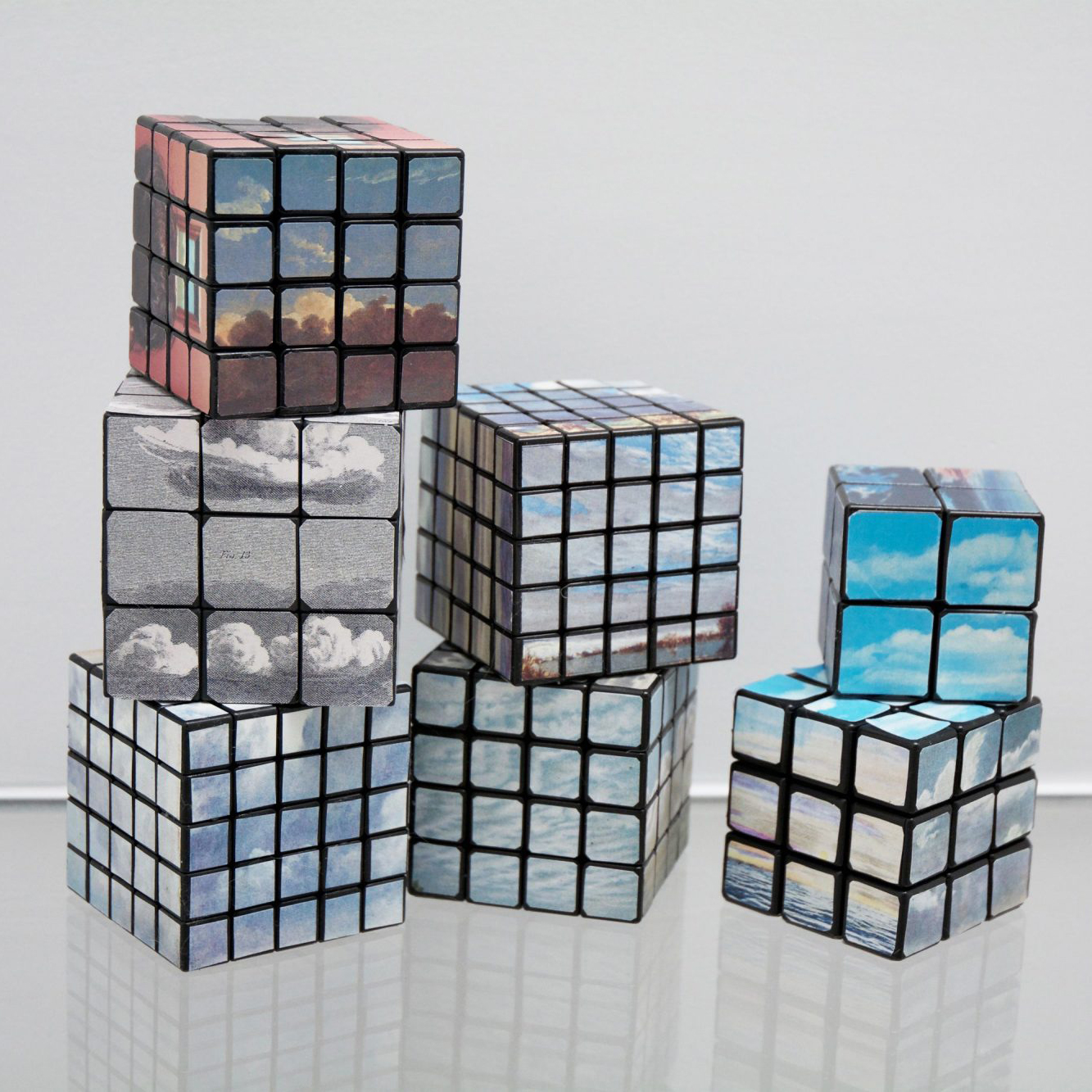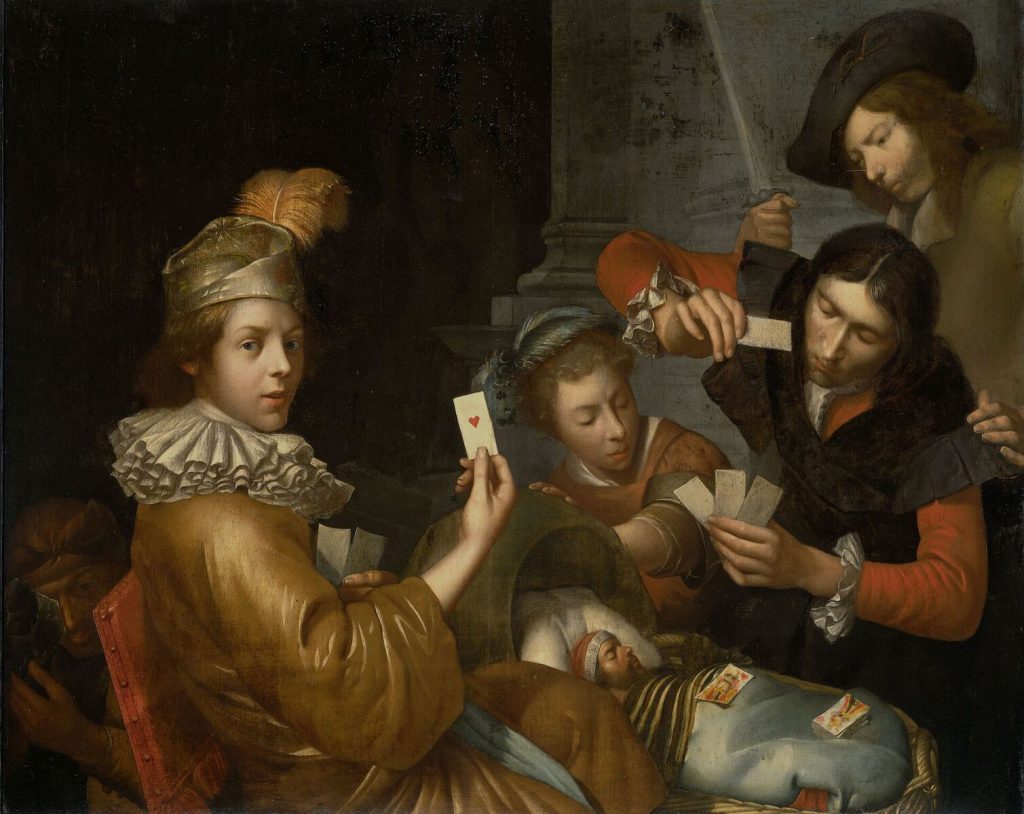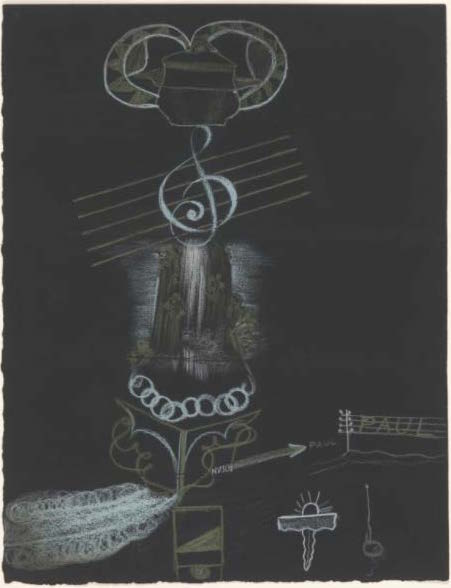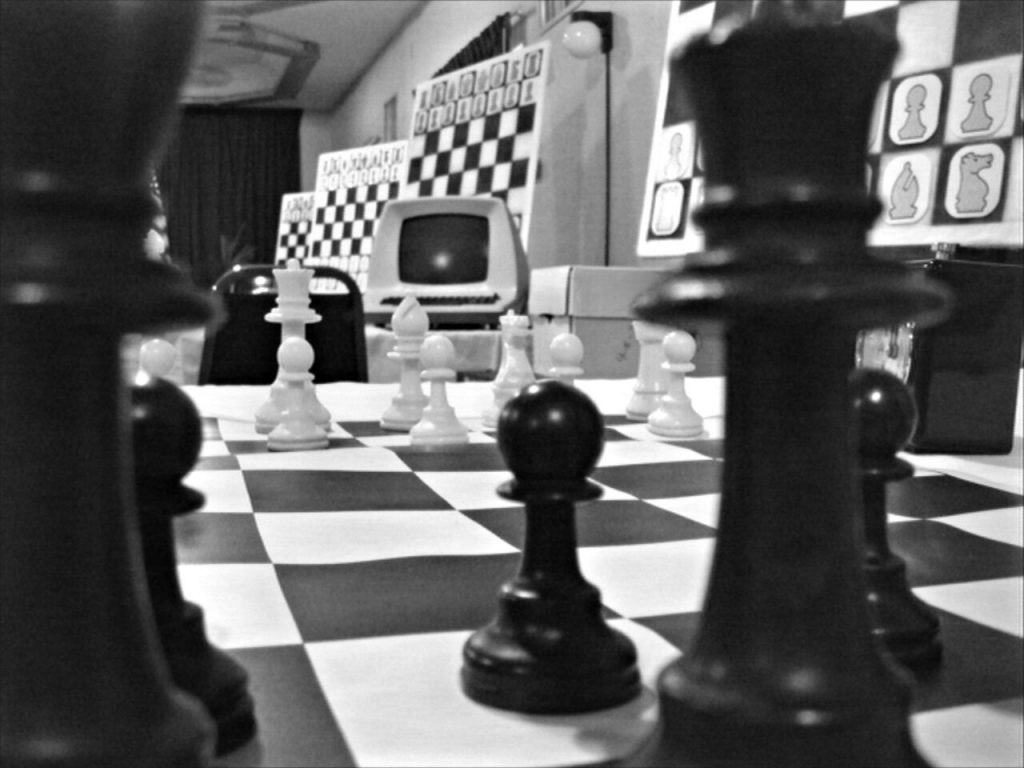Poet Matthea Harvey conceived a series of modified Rubik’s Cubes accompanied by short meditations on its creator, its history, clouds, and some playfully absurd scenarios.
OF CLOUDS AND BOXES
How did the clouds get their names? In Genesis, Adam “gave names to all livestock and to the birds of the heavens and to every beast of the field,” but he didn’t name the clouds. When we name a thing, do we box it in? The names we know clouds by today were coined by chemist and amateur meteorologist Luke Howard in a lecture he gave to the Askesian Society in a London basement in 1803 and published as “Essay on the Modifications of Clouds” in 1805. His first classifications included cirrus or thread/hair cloud, cumulus or heap cloud, stratus, flat or level cloud, and cumulo-cirrus-stratus, later shortened to nimbus, or rain cloud. I picture Luke Howard in a room whirling with tiny clouds, catching them with butterfly nets, and carefully sliding each one into a glass box. But clouds are, by their very nature, changeable, capricious, liable to escape their taxonomic boxes by morphing from cirrus to cumulus in a meteorological instant. They’re the opposite of Rubik’s cubes, which, ideally, after much whirring, twisting, and clicking settle into one static finished form.
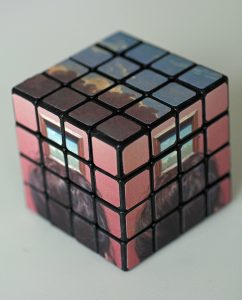
SISTER PUZZLES
My older sister Celia and I both got Rubik’s puzzles in 1981. As the younger sister, I got the easier one, a “sister puzzle” to the original Rubik’s cube—a green and white Rubik’s snake that I laboriously learned to transform into a Scottie dog (although according to the instruction manual I found online I was not making a Scottie; I was making a terrier). It didn’t occur to me that there were more possible shapes, but Rubik’s super-fan Thomas Wolter lists under “Easy Figures” some I would have liked to have learned: Cat, Dogface, Mushroom, and Swimming Bird. A number of them look nothing like their labels—it’s a strain to see the summer or house in Summerhouse, and Cardboard, Casket, Grotto, Microscope, and Snowman are equally iffily abstract. There’s even one called “Noname.” The more challenging list of “Hard Figures” presents other oddities—“Without Name” (how this differs from “Noname” I can’t say), Endless Belt, and Knot on Legs. Their names resemble dreamily looking for objects or animals in the clouds more than trying to create a true taxonomy . . . Celia had the real Rubik’s Cube and after weeks of maneuvering she managed to get to the point where all the sides were perfect save two, each marred by one incorrect square. Frustrated, she temporarily tossed it aside. I saw a simple solution, however, and helpfully peeled the errant red and yellow stickers off and switched them, leaving the perfected puzzle on her desk. She was (understandably, I see now) not pleased. In fact, switching the tabs makes the cube unsolvable, as noted in the pun-tastically titled poem “A Rubric on Rubik Cubics” by Claude E. Shannon, published in the last issue of Cubic Circular in 1985 (a quarterly newsletter dedicated to the Rubik’s Cube and other puzzles—indeed the world of Rubik’s Cube fandom is a rabbit hole of the first order): “Rude folk might switch two tabs on thee, / The most unkindest switch of all, Into insolubility. In-sol-u-bility. / The cruelest place to be. / However you persist / Solutions don’t exist.”
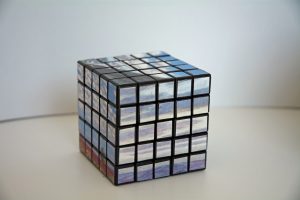
NAMING AND THE CUBE
Until quite recently I thought “Rubik’s” was spelled “Rubix” and had given no thought to a person behind the puzzle. But there is a Mr. Rubik—Ernö Rubik, who is still alive today, a Hungarian inventor who first came up with his cube in 1974 while teaching a class at the Academy of Applied Arts and Crafts in Budapest. His first model was cobbled together out of wood and rubber bands. When the cube first went on the market in Hungary it was called Buvos Kocka or “Magic Cube,” but when it was brought to the US five years later it was renamed “Rubik’s Cube,” because, according to the Rubik’s Cube official website, “Ideal Toy’s executives thought that the name had overtones of witchcraft.” Other names under consideration included “Inca Gold” and “Gordion Knot” (legend has it that Alexander the Great “solved” the impossible-to-untie Gordion knot by simply slicing through it with his sword so perhaps my sticker-switching crime was simply a clever way of solving the problem). A New York Times article notes that Ernö Rubik calls it “my cube. From my mouth, it sounds strange to call it ‘Rubik’s cube,’ … If I have a child, I call it ‘my child,’ not ‘Rubik’s boy’ or ‘Rubik’s girl.’” Incidentally, Rubik has been married twice and has four children—two daughters, Agnes and Anna, with Rozsa, his first wife, and with his second wife (named Agnes like his daughter), a son, Ernö III and a third daughter, Szonja. Rubik’s father, an aircraft and glider designer, was the first Ernö Rubik. Our Ernö Rubik does not identify himself as the second or “II.” Hungarian naming conventions follow Eastern name order (surname first), so at home all three Ernös would go by Rubik Ernö. Rubik is a rare surname (related to Rubel, Rubig, Rubega, Rubiga, Robic, and Rubica), which may mean “a grower of corn oil plants or one who lived by such a place,” while the name Ernö means “serious business” or “battle to the death.” The umlaut over Ernö’s “o” should actually be double acute accents (also known as Hungarumlaut), which means that the letter is thought of as having both an umlaut and an acute accent. I can’t find this umlaut on my keyboard. Rubik’s mother, Magdolna Szántó was a poet, but her poetry is nowhere to be found. Missing: countless poems, the correct umlaut.
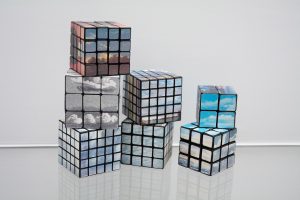
CUBE VOCAB
The origins of the word “cube” aren’t entirely clear. Etymological dictionaries credit the Middle French “cube,” Latin “cubus,” and Greek “kybos,” which refers to the six-sided die with which the Greeks played betting games. Before dice were used, this game was played with any four-sided bone harvested from a cow or sheep, which accounts for a secondary meaning for cube: vertebrae. So solving for etymology doesn’t end in a PB (personal best in cubing terminology)—it’s closer to DNF (did not finish). The Rubik’s cube is made of 26 cubes (in six colors) called cubies or cublets. Rubicubism describes the practice of creating mosaic-style art out of multiple Rubik’s cubes. These include recreations of the Mona Lisa, a photograph of Grumpy Cat, Warhol’s Marilyn Monroe silkscreens, as well as Michelangelo’s “God’s Hand” from the Sistine Chapel, which used 12,090 cubes. Should I call them sculptures or chunky paintings? They’re three dimensional but rely on the flat and they look like cruder versions of Georges Seurat’s pointillism, Chuck Close’s pixelated portraits, or perhaps Mona Lisa through the eyes of a house fly. In Cockney rhyming slang, you’d call those eyes “minces” referring to “mince pies,” which rhymes with “eyes.” Rubik’s cube means “pube” or “tube,” as in the London Underground. When speaking in this lingo, you often hide the rhyme, so you’d say, “oh no, there’s a Rubik’s on the soap!” or “The Rubik’s will get us there faster.” Rubik’s sells Cube Lube for just $5.99 to “achieve record beating times.” Non-Rubik’s brand lubes include Cubicle Silicone Lube, Lubix Cube, Shock Oil, and Jig-a-Loo. Would corn oil work too?
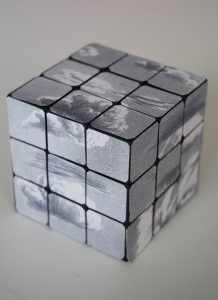
BY THE NUMBERS
Between two hands a whirl of jumbled colors, then the solved cube is tossed onto the table, each side a solid red, blue orange, green, yellow, or white—order wrested from chaos. There are 43 quintillion possible arrangements of the Rubik’s Cube but only one solution. Rubik says of the cube, “it was a code I myself had invented! Yet I could not read it. I simply could not accept it.” It took him approximately a month to unscramble the puzzle he’d invented. Between 1 and 2.5 billion Rubik’s cubes have been sold, if you include knockoffs, of which there are many. Ron van Brunchen, a speedcuber from Amsterdam has over 1,000 cubes in his house, including some in his bathroom and shower. When asked if they are waterproof, he demurs, “Well, I have specific cubes that I save for water-solves, yeah.” According to The Daily Mail, one man recently solved the cube for the first time after 26 years of trying. His wife, understandably, complained of feeling like there were “three people” in their relationship. In 1982 Minh Thai solved the cube in less than 23 seconds. Last year Feliks Zemdegs, age 20, solved it in less than five seconds—4.73 seconds to be exact. I watched a video of his lightning-fast solving and I regret to report that he was very excited by his win—and by that I mean visibly turned on. Only eight percent of speedcubers are women. The most expensive Rubik’s cube, named the Masterpiece Cube was created in 1995. Its value has been estimated from $1.5 to 2.5 million and it’s made of 1360 jewels set in 18 karat yellow gold. It includes 22.5 karats of amethyst, 34 karats of rubies, 34 karats of emeralds, and an unspecified amount of sapphires and white diamonds. The creator and owner of the cube, Fred Cuellar refuses to sell the cube and has said that he plans to donate it to the Smithsonian. According to his company, Diamond Cutters International, Cuellar also made a $2 million pizza for Little Caesar’s with 600 carats of diamonds and other colored stones set in five pounds of gold. Cuellar, who has published a number of books, including one of clichéd aphoristic sayings titled “Fredisms,” was convicted in 1998 for swindling a group of 70 people out of $1 million dollars which was meant to be used to purchase two large diamonds. Interviewed on a podcast titled “The Nice Guys on Business,” he mentions that his mantra is “Live to benefit others.”
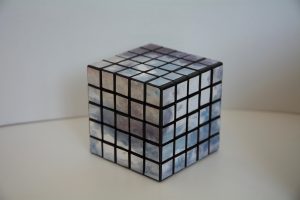
CLOUD CUBES
I’m currently writing a book about clouds called All of the Above, which has led me to take Polaroids of all the cloud and cloud-like apparitions that appear on Keeping Up With the Kardashians (and create a tongue-in-cheek taxonomy for them). That’s a long story for another time, but KUWTK often repeats footage of clouds reflected in an office building gridded with windows. I think that’s where I got the idea to make Rubik’s cubes covered in clouds. I made one Cloud Cube from a vintage print of Wolkenformen (cloud forms) from Meyer’s Koversations Lexicon published in the 1890s. The lithograph itself is already a four-by-three grid of images showing twelve clouds (but only nine types). For my cube I chose two different cirrus, a nimbus, a cumulus, an alto-cumulus, and a cumulo-nimbus. To cover another cube, I used a black-and-white etching from the 1890s that may or may not be from McKenzie’s National Encyclopedia: A Dictionary of Universal Knowledge. Because the British landscape painter John Constable is famous for his clouds and for saying, “I have done a good deal of skying” (i.e. looking at and painting the clouds), there is, of course, a Constable cube. Three of the Cloud Cubes use photocopies of cloud scenes from vintage cloud postcards purchased on eBay and labeled with titles like “Above the Clouds, Mount Wilson, California,” “Moonlight on the Straits of Mackinac, Near Cheboygan, Michigan,” “Sunrise above the Clouds, Mt. Washington, White Mts, N.H.,” “Sunrise above Clouds From Mt. Leconte,” “Above the Clouds from Echo Mountain,” “‘Fleecy Clouds & Seascape’ off Australian Coast,” and “Sunset Over Clouds, Mt. Lowe, Cal.” For a more autobiographical cube, I used a photograph of the back of my head beneath my favorite cloud painting at the Metropolitan Museum of Art (Cloud Study (Early Evening) by Simon Denis, painted sometime between 1798 and 1806). The painting is 8 7/8 x 10 1/8 inches whereas the standard Rubik’s Cube is 2 ¼ inches squared, so the painting could be obscured by placing 17.8 Rubik’s Cubes on its surface. In my eBay searches I stumbled across a set of French trading cards showing six cloud-types. When they arrived, I was thrilled to discover ads for Oxo cubes on the back. Bouillon boo-yah! By accident I’d stumbled upon another world of cubes, whose collectors are almost as obsessive as speedcubers and Rubik’s cube collectors. My trading cards were produced by the Liebig Company in 1933 but the cards began being produced in the 1870’s by a company named for Justus von Liebig who is credited with creating meat extract. Liebig published his recipes in a tract tiled “Extractum Carnis” and his extract was later sold as meat paste or bouillon cubes. The Liebig Company produced 11,000 different sets of these cards. On the front are a variety of images—some of them quite unremarkable, like my set of clouds or a grouping of famous composers, but there are also much stranger categories, such as “Children with Big Cooking Utensils (I and II) ” from 1872–73, in which boys in knickers and caps and girls in short dresses, aprons, and bows hoist a giant teacup and saucer or stab a giant cheese with an oversized knife. Or the equally odd “Race of the Wooden Horses” from 1873–78, in which boys in tiny jockey outfits “race” by hoisting their immobile steeds over hedges or falling off them into a stream. This particular scenario seems like a cousin to my Cloud Cubes, which are essentially unsolvable (if the Rubik’s cube has 43 quintillion possible patterns and only one correct solution, my Cloud Cubes have exponentially more, given that no two squares on any side are alike) and therefore have to stay frozen in their original configuration. Having taken a toy and made it impossible to play with (a Jack-in-the box with no Jack, a pogo-stick that won’t bounce) feels a bit mean, so it’s heartening to see these children playing happily with their inert ponies.
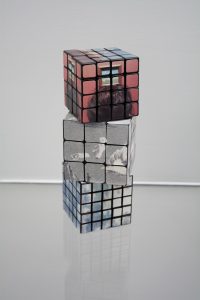
SIZE MATTERS
There have been multiple attempts at miniaturizing the Rubik’s cube. Evginy Grigoriev initially made a 12mm cube, followed by a 10mm, then an 8mm cube, followed by Callum making a 6mm cube. Grigoriev followed up with a 5.9mm cube and finally Tony Fisher filed down one of Callum’s 6mm cubes to make a 5.4mm cube, though as he points out that this version, while functional, is not perfectly proportional and as a result, “it might not actually count as a Rubik’s cube.” Fisher also points out that the cubes’ measurements do not include the square stickers and that to be perfectly precise, each of the tiny cubes should add 0.2 mm to their final sizes. Fisher does currently hold the Guinness World Record for tiniest Rubik’s cube (listed as 5.6mm so as to include the stickers). YouTube videos of the tiny Rubik’s cubes share a flair for the dramatic. In a demo video for the 8mm cube (3-D printed by Shapeways), the tiny Rubik’s cube arrives in a large shipping box and is ceremonially unpacked and assembled. In Fisher’s demonstration of his modified mini cube, the camera shows a giant Rubik’s cube (Fisher also holds the 2016 Guinness Book of World Record title for the largest Rubik’s cube, which is 1.57 meters (or five feet, 1.7 inches) on each side and zooms in to show the tiny one perched on top of it. Fisher uses tweezers and a magnifying glass to painstakingly manipulate (and solve!) the mini cube. His fingers look the size of shovels.
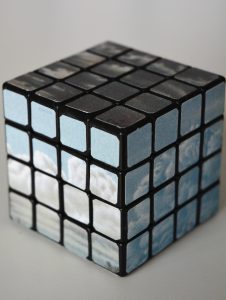
MAKE IT HARDER
Solve on waterskis. Solve 839 on a 26.2 mile run. Solve in winter while wearing a yellow puffy coat and bouncing on a very creaky pogo stick (ask your exchange student to scramble the cube and time you). Wearing goggles and plaid swim trunks, solve three in a row underwater in less than a minute (yes, Rubik’s cubes float). Solve while strapped into a multi-axis trainer, a hexagon that spins within two giant metal circles to simulate the disorientation astronauts feel upon reentry into the earth’s atmosphere. Solve blindfolded in 1.2882 minutes. On your back deck, next to your doormat and two potted plants, solve in 25 seconds while doing one-handed pushups, shoeless and shirtless. Solve 1,010 while riding a bicycle for over six hours. Solve one-handed while riding a bicycle around London’s crowded Hyde Park. Solve with your nipple. Please note: none of these feats were attempted by women or girls.
(Image credits: All photographs courtesy of Matthea Harvey.)


